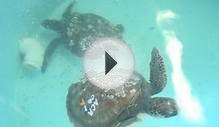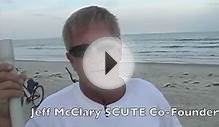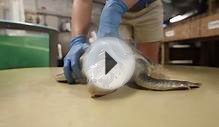
The NC Sea Turtle Project was created to monitor sea turtle activity along the entire coast of North Carolina. Sea turtle biologists with the NC Wildlife Resources Commission work to recruit and train volunteers as well as others that participate in the project, including the Fish and Wildlife Service, the National Park Service, and various State Parks/Recreation Areas. The biologists ensure guidelines regarding proper monitoring techniques are followed and provide any assistance where needed. All the data collected by the project are then organized and disseminated to the state and federal agencies that use the information to make management decisions. The biologists often attend meetings regarding activities along the coast (such as dredging, renourishment, ORV use, development, and fisheries) that may have a negative impact on sea turtle populations. They also collaborate with other research projects aimed at learning more about NCs sea turtles, including satellite tagging of nesting females, movements of juvenile sea turtles in inshore waters, and sand temperature studies.
- Starting in May, female sea turtles begin laying their eggs on North Carolina beaches. Each nest, or clutch, contains approximately 120 eggs roughly the size of a ping pong ball. The female digs a chamber in the sand about 1-2 feet below the surface and once the eggs are deposited, she covers them up with sand. Except for the distinct track she has left in the sand, the nest is completely camouflaged. A female turtle will return every 2 weeks or so to lay another clutch of eggs. She may lay between 4-7 clutches in one season. Once the water temperatures start to cool again in August, the females move on in search of food and a decent place to reside until it is time to nest again. Typically, a female nests every other or every 3rd year. In North Carolina, the majority are loggerheads, with a few green turtles and leatherbacks nesting each year. There have only been 2 ever recorded Kemp's ridley nests in NC. Once laid, the eggs are on their own. They incubate for approximately 60 days, but nests laid early in the season, in the shade of vegetation or buildings, or during cool weather periods could take up to 100 days.
- With the help of hundreds of project participants, the entire NC coastline is monitored every morning from May through August in search of turtle tracks. Once found, the nest has to be verified. Since sea turtles can be very picky about where they lay their nests, it is common for a female to crawl up the beach only to return to the ocean without laying a nest if the site did not suit her, or if she was scared away. This is called a false crawl. In order to verify that a nest is present and it is not just a false crawl, trained participants know how to "read" the markings left in the sand and know where to dig very carefully below the surface to find the nest. Once eggs are found, the nest is immediately covered back up. The area is protected using stakes and flagging tape and is identified with a sign. Some nests are covered with wire cages on beaches where predators like raccoons and fox are a problem. Usually that is all that is needed to ensure the nest remains undisturbed. The nests are checked everyday for signs of disturbance, as well as overwash from high tides. Participants also check for signs that the nest is getting ready to hatch, usually nothing more than a distinct depression or hole in the sand.
- Once ready to hatch, barriers are often constructed to decrease the chance of hatchlings getting stepped on, run over, or confused by lights. They take several days to hatch out and crawl to the surface of the sand as a team, and then when ready, they break the surface and scramble to the sea. This usually occurs at night time, and is referred to as a boil. In most cases, hatchlings can make it to the sea without any assistance from humans (and we discourage any unnecessary interfering). Many participants start a vigil on a hatching nest solely to marvel in the spectacle and share the experience with their fellow volunteers. On many occasions passers-by will also join the group in hopes of witnessing the event. This provides a great opportunity to interact with the public and volunteers are always willing to answer questions. In the event that there are a lot of people on the beach when the nest hatches, or the hatchlings become disoriented and crawl away from the sea into the dunes, it is very helpful to have knowledgeable volunteers on hand to keep the area clear or get the hatchlings headed in the right direction.
- Approximately 3 days after the hatching event, project participants conduct an excavation, or inventory, of the nest. The nest will be filled with empty eggshells, and each shell must be counted. In addition, some underdeveloped eggs may be present. On occasion there are a few hatchlings still at the bottom of the nest - ones that didn't quite make it out with the others. Unfortunately, sometimes these hatchlings are dead, but often they are alive and just need assistance to get out of the nest chamber. Releasing these few turtles is a big crowd pleaser! The nest inventory helps determine the success of the nest - both the hatching success (percentage of turtles that hatched from their eggs) and the emergence success (percentage of turtles that emerged from the nest un-aided by humans). These numbers as well as the total number of nests laid, and the number of false crawls help give biologists a glimpse at how the nesting population of turtles is faring.
- A stranding occurs when a dead (or sometimes live but sick or injured) sea turtle washes up on the shoreline. It is important to record every stranding as the information can be very useful to biologists and managers who are trying to protect the species. Records of dead or injured turtles floating in the water are also taken. On average, a total of 468 sea turtles strand in North Carolina each year. Biologists from the North Carolina Wildlife Resources Commission are responsible for tending to and collecting data from these strandings. This requires a lot of help from volunteers and other members of the stranding network. These people are trained and are willing to tend to a stranding at a moments notice. It is important to act quickly, especially if the turtle is alive and needs medical attention, but also so that the turtle does not wash out with the tide or decompose too much, therefore losing important information. All of the data collected are eventually sent to the National Marine Fisheries Service, who collects and manages stranding data for all of the...
RELATED VIDEO












